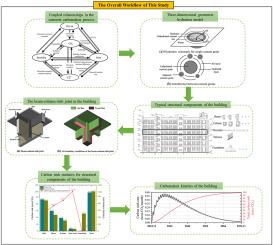混凝土结构碳汇建模:从水化动力学到气候驱动的碳化
IF 5.8
2区 化学
Q2 CHEMISTRY, MULTIDISCIPLINARY
引用次数: 0
摘要
据估计,混凝土生产约占全球温室气体排放量的9%。然而,由于碳化反应,混凝土建筑在其使用寿命期间会从空气中吸收二氧化碳。为了准确预测混凝土建筑的碳汇,建立了混凝土建筑碳汇计算模型。该模型基于考虑水泥水化过程、传热、水分输送和碳化的动力学模型。此外,还考虑了时变暴露条件(TVEC),包括气候的长期和季节性变化。在案例研究中,该模型应用于某学校建筑,并在代表性浓度路径8.5 (RCP8.5)情景下进行了碳酸化模拟。结果表明,该建筑50年的碳汇为99.03吨,相当于混凝土生产过程中产生的约27.6%的碳汇。此外,还对建筑碳汇的动态演变及影响碳汇的因素进行了细致的分析。本文章由计算机程序翻译,如有差异,请以英文原文为准。

Modeling of carbon sink for concrete structures: From hydration kinetics to climate-driven carbonation
Concrete production is estimated to contribute approximately 9 % of global greenhouse gas emissions. However, due to carbonation reactions, concrete buildings absorb CO2 from the air during their service life. In order to accurately predict the carbon sink of concrete buildings, a carbon sink calculation model was developed. This model is based on a kinetic model that considers the cement hydration process, heat transfer, moisture transport, and carbonation. Moreover, time-varying exposure conditions (TVEC) are considered, including long-term and seasonal variations in climate. In the case study, the model was applied to a school building, and carbonation simulations were conducted under the Representative Concentration Pathway 8.5 (RCP8.5) scenario. The results show that the carbon sink of the building was 99.03 tons over 50 years, equivalent to approximately 27.6 % of the emissions generated during concrete production. In addition, the dynamic evolution of the building's carbon sink and the factors affecting the carbon sink were carefully analyzed.
求助全文
通过发布文献求助,成功后即可免费获取论文全文。
去求助
来源期刊

Sustainable Chemistry and Pharmacy
Environmental Science-Pollution
CiteScore
8.20
自引率
6.70%
发文量
274
审稿时长
37 days
期刊介绍:
Sustainable Chemistry and Pharmacy publishes research that is related to chemistry, pharmacy and sustainability science in a forward oriented manner. It provides a unique forum for the publication of innovative research on the intersection and overlap of chemistry and pharmacy on the one hand and sustainability on the other hand. This includes contributions related to increasing sustainability of chemistry and pharmaceutical science and industries itself as well as their products in relation to the contribution of these to sustainability itself. As an interdisciplinary and transdisciplinary journal it addresses all sustainability related issues along the life cycle of chemical and pharmaceutical products form resource related topics until the end of life of products. This includes not only natural science based approaches and issues but also from humanities, social science and economics as far as they are dealing with sustainability related to chemistry and pharmacy. Sustainable Chemistry and Pharmacy aims at bridging between disciplines as well as developing and developed countries.
 求助内容:
求助内容: 应助结果提醒方式:
应助结果提醒方式:


